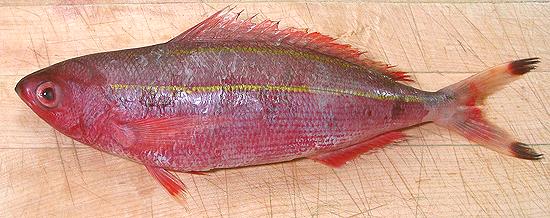 [Redtail Fusilier (Market); Pterocaesio marri]
[Redtail Fusilier (Market); Pterocaesio marri]
This Indo-West Pacific fish can grow to nearly 14 inches but is generally marketed smaller. The photo specimen was 11-3/4 inches and weighed 12-3/4 ounces. It is a popular eating fish in the Philippines so it can be found in the big Philippine markets that abound here in Los Angeles.
Apparently Twinstripe Fusiliers vary greatly in color. The ones available here in Los Angeles are very red and marked "Redtail Fusilier", but Fishbase and other sources list no such name and don't have photos of any that color.
More on Fusiliers
the Twinstripe Fusilier is a meaty fish and its flesh has an interesting medium flavor. The dark layer under the skin is small and does not have a strong taste. The flesh is extremely tender raw, but it becomes very firm with cooking. This fish has a number of problems, so read these notes carefully.
The flesh firms up and holds together with wet cooking so it can be used in soup. Chunks may be skin-on or skin-off, but should go in not long before serving. The chunks won't fall apart, but they may get overly firm and have a dry texture, probably because this fish has so little oil. Skin-on pieces will curl.
Pan dressed fish steam well and disassembling them on the plate is quite manageable, especially if the ribs have been pulled out of the tender flesh before cooking.
Buying: This is a popular fish in the Philippines, so is very easily available here. In Los Angeles there's a Philippine market near every large hospital complex, because our health care system runs mostly on Filipino immigrants. The photo specimen was purchased in Los Angeles (Eagle Rock) for 2016 US $3.49 per pound.
Scales: This fish is completely covered with small scales that scrape off easily with very little flying about.
Cleaning The body cavity extends significantly beyond the vent, so make your cut from right in front of the anal fin forward to under the chin. The gills pull easily, but the aperture is small, so use your long nose pliers. There is a fair amount of stuff up in the head that's not easy to get out, so, unless you want a head-on fish, cut the head off early.
Fillet: This is an easy fish to fillet with an easy to follow bone structure - but the flesh is very tender and flakes apart with the slightest abuse, so handle it gently. Cut off the tail and make a cut on each side of the anal fin forward into the body cavity. Cut down from the top to the backbone, then over the backbone at the tail end and forward until you get to the rib cage. Cut the ribs off the backbone with kitchen shears and pull them from the fillet - they pull very easily. There are very significant long, hard, sharp centerline pin bones for the full length of the body cavity. They are easy to locate and pull from the tender flesh.
Skin: The skin has no strong or "off" flavor, but shrink is severe. This is a problem, as you can't really skin these fillets, because the skin is the only thing holding the fillet together. This means fillets cannot be poached, they'll curl up tight. I happen to really like these fillets pan fried with just a dusting of rice flour, so I start them skin side up until the fillet is stiffened, When I turn it skin side down, I force it flat with the turner. In about 20 seconds the skin shrinks and thickens the fillet considerably, but it will stay flat. Skin is still tightly attached after cooking so cannot be easily peeled off.
Yield: An 11 inch, 10-7/8 ounce fish yielded 6-1/4 ounces of skin-on fillet (57%), 5-3/4 ounces skin-off (52%). The skirt area is small and thin. Best, even with a whole pan dressed fish, to pull the ribs out and cut the skirt off.
Stock: The heads, bones and fins make a rather murky stock with a strong flavor I don't like.
sf_fusitsz 060704 r 160424 - www.clovegarden.com